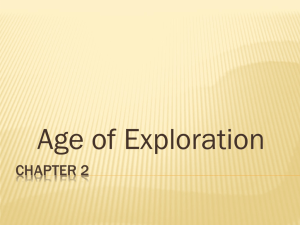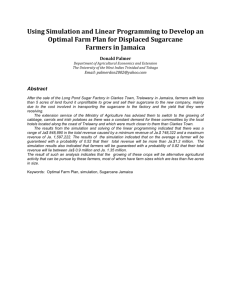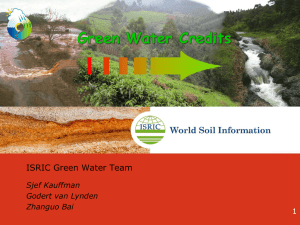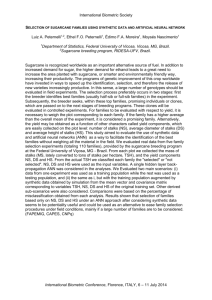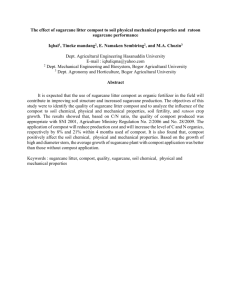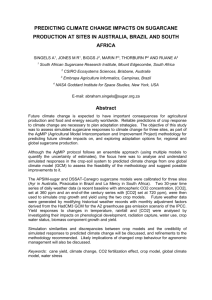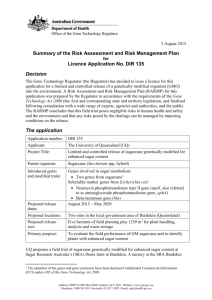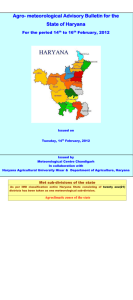Science Journal of Agricultural Research and Management Published By ISSN: 2276-8572
advertisement
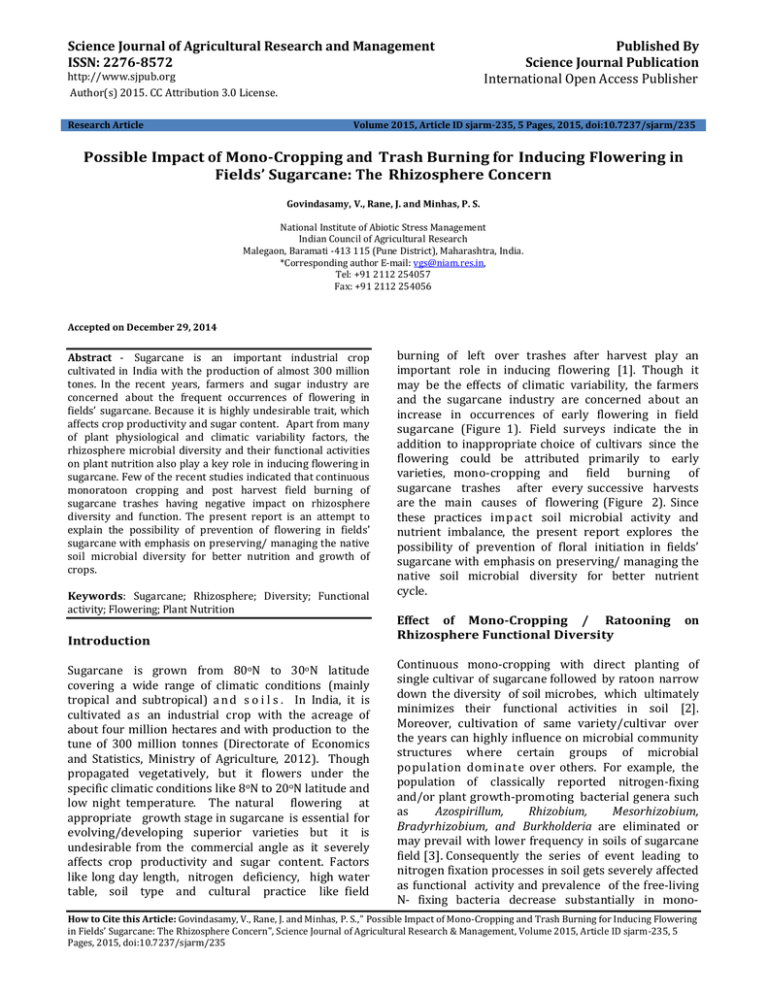
Science Journal of Agricultural Research and Management ISSN: 2276-8572 http://www.sjpub.org Author(s) 2015. CC Attribution 3.0 License. Research Article Published By Science Journal Publication International Open Access Publisher Volume 2015, Article ID sjarm-235, 5 Pages, 2015, doi:10.7237/sjarm/235 Possible Impact of Mono-Cropping and Trash Burning for Inducing Flowering in Fields’ Sugarcane: The Rhizosphere Concern Govindasamy, V., Rane, J. and Minhas, P. S. National Institute of Abiotic Stress Management Indian Council of Agricultural Research Malegaon, Baramati -413 115 (Pune District), Maharashtra, India. *Corresponding author E-mail: vgs@niam.res.in, Tel: +91 2112 254057 Fax: +91 2112 254056 Accepted on December 29, 2014 Abstract - Sugarcane is an important industrial crop cultivated in India with the production of almost 300 million tones. In the recent years, farmers and sugar industry are concerned about the frequent occurrences of flowering in fields’ sugarcane. Because it is highly undesirable trait, which affects crop productivity and sugar content. Apart from many of plant physiological and climatic variability factors, the rhizosphere microbial diversity and their functional activities on plant nutrition also play a key role in inducing flowering in sugarcane. Few of the recent studies indicated that continuous monoratoon cropping and post harvest field burning of sugarcane trashes having negative impact on rhizosphere diversity and function. The present report is an attempt to explain the possibility of prevention of flowering in fields’ sugarcane with emphasis on preserving/ managing the native soil microbial diversity for better nutrition and growth of crops. Keywords: Sugarcane; Rhizosphere; Diversity; Functional activity; Flowering; Plant Nutrition Introduction Sugarcane is grown from 80oN to 30oN latitude covering a wide range of climatic conditions (mainly tropical and subtropical) a n d s o i l s . In India, it is cultivated a s an industrial crop with the acreage of about four million hectares and with production to the tune of 300 million tonnes (Directorate of Economics and Statistics, Ministry of Agriculture, 2012). Though propagated vegetatively, but it flowers under the specific climatic conditions like 8oN to 20oN latitude and low night temperature. The natural flowering at appropriate growth stage in sugarcane is essential for evolving/developing superior varieties but it is undesirable from the commercial angle as it severely affects crop productivity and sugar content. Factors like long day length, nitrogen deficiency, high water table, soil type and cultural practice like field burning of left over trashes after harvest play an important role in inducing flowering [1]. Though it may be the effects of climatic variability, the farmers and the sugarcane industry are concerned about an increase in occurrences of early flowering in field sugarcane (Figure 1). Field surveys indicate the in addition to inappropriate choice of cultivars since the flowering could be attributed primarily to early varieties, mono-cropping and field burning of sugarcane trashes after every successive harvests are the main causes of flowering (Figure 2). Since these practices impact soil microbial activity and nutrient imbalance, the present report explores the possibility of prevention of floral initiation in fields’ sugarcane with emphasis on preserving/ managing the native soil microbial diversity for better nutrient cycle. Effect of Mono-Cropping / Ratooning Rhizosphere Functional Diversity on Continuous mono-cropping with direct planting of single cultivar of sugarcane followed by ratoon narrow down the diversity of soil microbes, which ultimately minimizes their functional activities in soil [2]. Moreover, cultivation of same variety/cultivar over the years can highly influence on microbial community structures where certain groups of microbial population dominate over others. For example, the population of classically reported nitrogen-fixing and/or plant growth-promoting bacterial genera such as Azospirillum, Rhizobium, Mesorhizobium, Bradyrhizobium, and Burkholderia are eliminated or may prevail with lower frequency in soils of sugarcane field [3]. Consequently the series of event leading to nitrogen fixation processes in soil gets severely affected as functional activity and prevalence of the free-living N- fixing bacteria decrease substantially in mono- How to Cite this Article: Govindasamy, V., Rane, J. and Minhas, P. S.," Possible Impact of Mono-Cropping and Trash Burning for Inducing Flowering in Fields’ Sugarcane: The Rhizosphere Concern", Science Journal of Agricultural Research & Management, Volume 2015, Article ID sjarm-235, 5 Pages, 2015, doi:10.7237/sjarm/235 2|P a g e S c i e n c e J o u r n a l o f A g r i c u l t u r a l R e s e a r c h a n d M a n a g e m e n t I S S N : 2 2 7 6 - 8 5 7 2 cropping system. Further, changes in rhizospheric microbial diversity in sugarcane field also reduces functional activities of other microbial groups involved in nitrogen transformation processes like Nmineralization, nitrification and de-nitrification in soil, which ultimately reduce available N for sugarcane (Figure 3). This is indicated from the fact that farmers are rarely benefited by application of N- rich spent wash (a byproduct from distillation of molasses for the production of alcohol in sugar industries) possibly due to reduction of microbial population that is responsible for nitrogen transformation processes. Though, sugarcane is naturally associated with an obligate Nfixing bacterial endophyte Gluconacetobacter diazotrophicus [4], the N nutrition through fixation decided by its internal cells density, which may effected by agronomic practices. Fertilizer dose and application schedule followed by the farmers of many sugarcane growing regions which also given in the table 1 indicates the addition of less than the recommended dose of N, but more of P and K. High levels of nitrogen prolongs the vegetative growth in plants, its high availability especially during prefloral initiation stages may reduce or delay the flowering in sugarcane and extend vegetative growth. Hence, application of 25 per cent excess N, a fortnight ahead (end of 5th month of planting) and avoiding irrigation during September second fortnight (if there is no rainfall in September a n d October) a re short term measures t o reduce flowering in field sugarcane. However in long term, improvement in soil microbial structure, function and nutrient dynamics can be accomplished by the crop diversification with leguminous crops. This has been demonstrated in both intercropping as well as crop rotation for 3 years with sugarcane plant + sugarcane ratoon + legumes/ groundnut +green manure and/ others [5, 6]. Impact of Sugarcane Trash Burning on Soil Microbial Activities and Nutrients Availability In India approximately 6.5 million tonnes of sugar cane trash are being produced every year. A major portion of this is usually burnt in the field due to lack of proper post harvest trash management techniques. The trash burning significantly reduces total bacterial and fungal counts and hence can affect soil nutrient transformation (C, N, and P cycles) processes. Approximately the trash constitutes 7-10% of total cane yield and its nutrient content has been estimated to be around 0.35% N, 0.15% P and 0.57% K besides 26, 2045, 236 and 17 ppm of Zn, Fe, Mn and Cu, respectively [7,8]. As a consequence of bu r ni n g o f sugarcane trash in the field, more than 70% of the organic matter (leads to low soil organic C) and nutrients of N & S (leads to low soil N) in the trash are lost to the atmosphere [6, 9]. However, the high levels of K (~60 kg) and P (~15 kg) present in the ash left out after burning are added to soil available nutrients pool. However, it also leads to reductions in microbial biomass-C content (1.13%) and lowers the soil respiratory activity, and potential nitrification process [6, 10]. Reduced activities of major soil enzymes especially dehydrogenase and urease activities has been reported that lead to low N- mineralization rates whereas there is no affect on phosphatase activity [11]. As flower initiation and formation is positively correlated with phosphorus supply, the increased soil phosphatase activity may result in high P mineralization from organic P originated from burnt trash and subsequent P availability to sugar cane. High levels of supplied potassium have been reported to promote flower emergence, flowering, and the number of viable seeds per tassel in sugarcane crop [12]. Potassium plays a key role in physiology of plants associated with flowering and quality of biologically manufactured sugar. Hence, excess potassium originating from the burnt trash (~60 kg) might be contributing to induction of flowering in sugarcane raised as a ratoon crop. Comparing fresh planting of sugarcane, the established rooting system of ratoon crop can accumulate potassium more rapidly from the burnt trash as well as from K fertilizers that are applied subsequently (Table 1). Hence, flowering can be seen earlier in ratoon than in freshly planted sugarcane. Therefore, instead of field burning of sugarcane trashes, by following appropriate post harvest trash management practices viz., sugarcane trash mulching, composting of trashes and application of composted trashes as organic manure can improve soil microbial diversity, their functional activities and dynamics of soil carbon and major nutrients (NP&K). These changes can also have a positive effect t o reduce o r stop f l o w e r i n g problem in f i el d sugarcane and to ultimately increase cane yield and sugar quality. Alternatively, converting sugarcane trash biomass into “biochar” can significantly increase soil fertility by carbon capture and storage in soils and this practice can also help to mitigate climate change through carbon sequestration. How to Cite this Article: Govindasamy, V., Rane, J. and Minhas, P. S., " Possible Impact of Mono-Cropping and Trash Burning for Inducing Flowering in Fields’ Sugarcane: The Rhizosphere Concern", Science Journal of Agricultural Research & Management, Volume 2015, Article ID sjarm235, 5 Pages, 2015, doi:10.7237/sjarm/235 3|P a g e S c i e n c e J o u r n a l o f A g r i c u l t u r a l R e s e a r c h a n d M a n a g e m e n t I S S N : 2 2 7 6 - 8 5 7 2 References 1. Gosnell JM (1973) Some factors affecting flowering in sugarcane. Proc S Afr Sug Technol Ass 47:144-147 2. Wallis PD, Haynes RJ, Hunter CH, Morris CD (2010) Effect of land use and management on soil bacterial diversity as measured by PCR-DGGE. Appl Soil Ecol 46:147-150 3. Pisa G, Magnani GS, Weber H, Souza EM, Faoro H, Monteiro RA, Daros E, Baura V, Bespalhok JP, Pedrosa FO, Cruz LM (2011) Diversity of 16S rRNA genes from bacteria of sugarcane rhizosphere soil. Braz J Med Biol Res 44:12151221 4. 5. Reinhold-Hurek B, Hurek T (2011) living inside plants: bacterial endophytes. Curr Opin Plant Biol 14:435-443 6. Suman A, L a l M , S i n g h A K , G a u r A ( 2006) Microbial biomass turnover in Indian subtropical soils under different sugarcane intercropping systems. Agron J 98:698-704 7. Hemwong S, Toomsan B, Cadisch G, Limpinuntana V, Vityakon P, Patanothai A (2009) Sugarcane residue management and grain legume crop effects on N dynamics, N losses and growth of sugarcane. Nutr Cycl Agroecosyst 99:84-97 8. Yadav DV, Singh T, Srivatsava AK (1987) Recycling of nutrients in trash with N for higher cane yields. Biol Wastes 20:133-141 9. Yadav DV (1995) Recycling of sugar factory pressmud in agriculture. In: Tandan HLS (ed) Recycling of crop, animal, human and industrial wastes in agriculture, Fertilizer development and consultation organization, New Delhi, pp 91-108 10. Graham MH, Haynes RJ, Meyer JH (2002) Soil organic matter content and quality: effects of fertilizer applications, burning and trash retention on a long-term sugarcane experiment in South Africa. Soil Biol Biochem 34:93-102 11. Yadav RL, Shukla SK, Suman A, Singh PN (2009) Trichoderma inoculation and trash management effects on soil microbial biomass, soil respiration, nutrient uptake and yield of ratoon sugarcane under subtropical conditions. Biol Fertil Soils 12. 45:461-468. 13. Pupin B, Nahas E (2010) Impact of successive sugarcane harvests and trash management practices on soil microbiological properties. Soil Res 49:183-189 14. Brunkhorst MJ (2001) A preliminary investigation into effect of plant nutrient levels on sugarcane flowering. Proc S Afr Sug Technol Ass 75:143-150 Table 1: Fertilizer application schedule by farmers of sugarcane growing region along with the recommended fertilizer dose for sugarcane Time 1stMonth 2nd Month 4th Month Total Recommended fertilizer dose for sugarcane Farmers’ practice* Quantity (Kg), Case-I 50-100 kg urea 10:26:26-100kg 10:26:26-100 kg Or 12:32:16-100kg 10:26:26-100 kg 30 (32): 78(84): 78(68)+ 46% of N in urea = 76(78) + 46 if another 100 kg urea= 122 (124) kg N. 275 kg N: 63 kg P2O5:113 kg K2O Quantity (Kg), Case-II 100 kg urea 12:32:16- 100kg 12:32:16- 100kg 10:26:26-100 kg 34:90:58 + 46% of N in urea = 80 + 46 if another 100 kg urea= 126 kg N. 3 splits in heavy textured (clayey) soils or 4 splits in light textured (sandy) soils *Farmers are adding less than the recommended dose of N, but applying excess of P and K (because of considerable quantity of P & K also added from burnt trash field), and application schedule completed within 4 month of planting. How to Cite this Article: Govindasamy, V., Rane, J. and Minhas, P. S., " Possible Impact of Mono-Cropping and Trash Burning for Inducing Flowering in Fields’ Sugarcane: The Rhizosphere Concern", Science Journal of Agricultural Research & Management, Volume 2015, Article ID sjarm235, 5 Pages, 2015, doi:10.7237/sjarm/235 4|P a g e S c i e n c e J o u r n a l o f A g r i c u l t u r a l R e s e a r c h a n d M a n a g e m e n t I S S N : 2276-8572 1a 1b Figure 1: Massive flowering of sugarcane in the farmers’ field at Malegaon, Baramati (Pune District), Maharashtra, India. How to Cite this Article: Govindasamy, V., Rane, J. and Minhas, P. S., " Possible Impact of Mono-Cropping and Trash Burning for Inducing Flowering in Fields’ Sugarcane: The Rhizosphere Concern", Science Journal of Agricultural Research & Management, Volume 2015, Article ID sjarm-235, 5 Pages, 2015, doi:10.7237/sjarm/235 5|P a g e S c i e n c e J o u r n a l o f A g r i c u l t u r a l R e s e a r c h a n d M a n a g e m e n t I S S N : 2276-8572 Figure 2: Post harvest burning of sugarcane trashes in the farmers’ field at Malegaon, Baramati (Pune District), Maharashtra, India. Figure 3: Schematic diagram representing impact of changing microbial diversity and functional activity in the rhizosphere of sugarcane mono-cropping system. How to Cite this Article: Govindasamy, V., Rane, J. and Minhas, P. S., " Possible Impact of Mono-Cropping and Trash Burning for Inducing Flowering in Fields’ Sugarcane: The Rhizosphere Concern", Science Journal of Agricultural Research & Management, Volume 2015, Article ID sjarm-235, 5 Pages, 2015, doi:10.7237/sjarm/235
